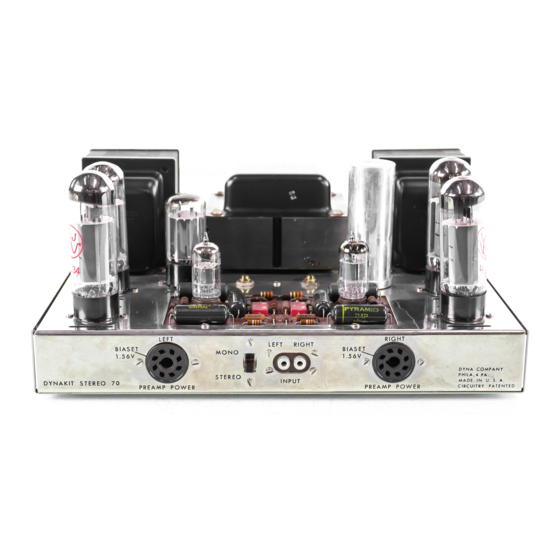DYNACO Stereo 70 조립 지침 - 페이지 10
{카테고리_이름} DYNACO Stereo 70에 대한 조립 지침을 온라인으로 검색하거나 PDF를 다운로드하세요. DYNACO Stereo 70 16 페이지. Series ii tube amplifier
DYNACO Stereo 70에 대해서도 마찬가지입니다: 복원 매뉴얼 (20 페이지), 복원 매뉴얼 (5 페이지), 소유자 매뉴얼 (12 페이지)

modate Dynakit monophonic preamplifiers without
modification.
The stereo 70 can be turned on and off from
the back panel switch, or this switch can be left in
"on" position, and the amplifier switched from one
of the switched ac outlets on the associated pre-
amplifier.
High-Low frequency amplification
For this type of operation the input switch on
the Stereo 70 should be put to "stereo" position.
The low frequency output of the dividing or cross-
over network should be fed to the left input, and
the "left" loudspeaker output should be connected
to the bass speaker. The high frequency output of
the diViding or cross -over network should be fed
through the right channel, and the tweeter con-
nected to the "right" loudspeaker terminal strip.
Monophonic 70 watt amplification
For monophonic operation, the two channels
of
the Stereo 70 may be paralleled. For this, only
one input cable is connected to either the left or the
right input (but not both), the input s witch is set to
"mono", and the outputs are connected together.
An
insulated wire jumper should be connected from
"c"
to
"c"
on the screw terminal strips. Another
insulated wire jumper should be connected from
"8" to "8"
if
a 4 ohm loudspeaker is used, or from
"16" to" 16" is an 8 ohm or 16 ohm loudspeaker is
used. When using the 16 ohm loudspeaker in this
fashion, the amplifier's maximum power output is
not as great because of the impedance. mismatch,
but there is no loss of power when using a 4 ohm
or 8 ohm loudspeaker as specified above. The
maximum power available into a 16 ohm loudspeaker
is still 55 watts, however, and there is a compen-
sating factor. The distortion, as levels below max-
imum, will be reduced by this type of connection.
What happens is that the operating conditions are
shifted from maximum power output to minimum
distortion.
This same operation can also be
achieved, of course, by connecting an 8 ohm loud-
speaker to paralleled 8 ohm taps, or a 4 ohm
loudspeaker to paralleled 4 ohm taps. Note that
whenever the two outputs are paralleled, only one
input cable should be used, the other input socket
should not be used, and the switch is on "mono".
It
is
also practical to use the "mono" position
with a single input source with two separate loud-
speakers.
In
this case, each speaker is connected
to one of the screw output strips using the imped-
ance which pertains to the respective speaker. No
jumpers are required between the output strips.
A monophonic preamplifier wh i c h requires
power from the amp 1
if
ie r can be connected to
either of the two power takeoff sockets.
8
ENJOYING STEREOPHONIC SOUND
S tel' e
0
ph
0
n i c sound
0
if
e r s an important
enhancement of enjoyment of your high fidelity
system. The proper setup and use of your stereo-
phonic system will bring considerable satisfaction.
However, stereophony introduces problems in high
fidelity reproduction which can dim in ish your
enjoyment of your hi
fi
system unless these prob-
lems are understood and corrected.
These few
notes on the subject should assist materially in the
installation and use of a stereophonic system which
adds to your listening pleasure.
The pieces of equipment to be used should be
as similar as possible in each channel.
This is
particularly true for the loudspeaker to be used.
Different types and brands of speakers have very
great differences in frequency response and other
important characteristics.
If,
for example, one
speaker has a peak in response at a certain fre-
quency where the other does not, the stereophonic
balance will be changed at that frequency.
The
need for frequent rebalancing is due to this type
of dissimilarity.
There has been a relatively high proportion of
dissatisfaction with stereo which has arisen be-
cause of the attempt to attach an inferior second
channel to complete a system.
If
this channel
differs from the first channel it frequently destroys
any potential benefits of stereophonic sound.
The proper reproduction of monophonic discs
through the stereo system requires the cancella-
tion of identical signals (of opposite phase) so that
there is no unwanted vertical signal component in
the output.
This requires either the parallelling
of the two sides of the cartridge or the parallelling
of the outputs of identical preamps.
If
the preamps
are slightly different, the vert i cal components
cannot be eliminated properly.
In
Dynakit pre-
amplifiers, the critical components which deter-
mine the response characteristics of the preamp-
lifier playback characteristics have a tolerance
of only 1
%
so that this pro b I e m cannot cause
difficulty.
Channel phasing is a problem of stereo which
is readily solved, once understood.
If,
on a single
sound, one speaker cone moves inward while the
other moves out, the s y s t em is not properly
phased, and the sound area between the speakers
will lack homogeneity. All tapes and all discs are
now reproduced so that their phasing is consistent.
Therefore, once phasing of the playback equipment
is set it can be maintained for all tape and disc
sources without further change.
To check for proper phasing, playa monophonic
recording so that one signal comes through both
channels. Then move back and forth between the
speakers.
If
phasing is correct, there will be a
